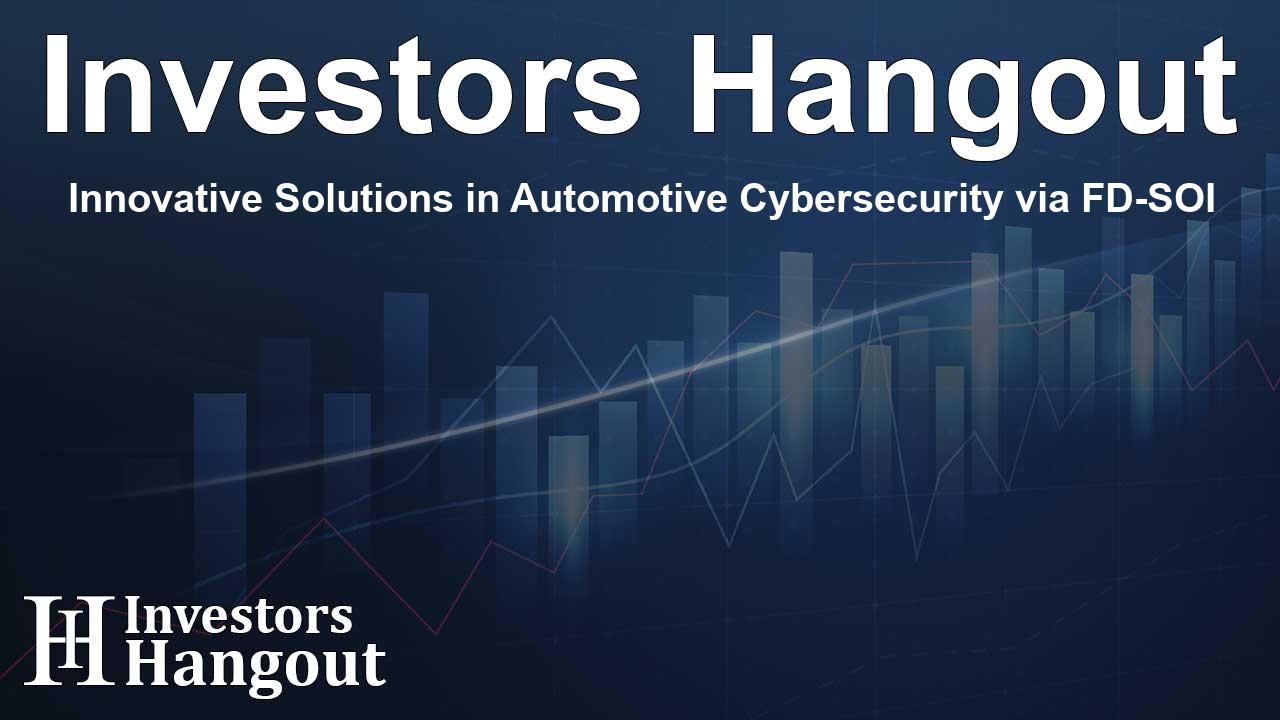Innovative Solutions in Automotive Cybersecurity via FD-SOI

Partnership Enhances Automotive Cybersecurity
In the ever-evolving landscape of automotive technology, the collaboration between Soitec and CEA represents a significant leap towards stronger cybersecurity measures. As our vehicles become more reliant on software and connectivity, the importance of securing hardware systems is paramount. Today’s automobiles are equipped with numerous microcontrollers, raising the stakes for potential vulnerabilities that cyber criminals could exploit.
Advancements in FD-SOI Technology
Soitec and CEA have unveiled the potential of Fully Depleted Silicon-on-Insulator (FD-SOI) substrates, which provide essential defenses against fault injection attacks. This type of attack has become a concern under the influential automotive cybersecurity guidelines set by the ISO/SAE 21434 standards.
Understanding Fault Injection Attacks
Fault injection attacks exploit vulnerabilities in a chip's normal functioning. An attacker may utilize a sudden voltage surge or laser light to disrupt operations, leading the hardware to behave erratically. This brief disruption can enable unauthorized access, allowing hackers to bypass security protocols and gain access to sensitive data.
The Precision of Laser Fault Injection
Among the various methods hackers employ, Laser Fault Injection (LFI) is highly effective and precise. It probes vulnerabilities at microscopic scales, making it a significant threat to both stationary vehicles and those in motion. Traditional silicon substrates often fail to protect against such intricate attack methods.
Unique Advantages of FD-SOI
FD-SOI technology stands out with its intrinsic protective features, including a buried oxide layer that effectively isolates the active film, reducing the risk of fault mechanisms. This built-in protection has been validated through extensive research conducted at CEA-Leti laboratories.
Research and Testing Outcomes
In comparative studies between 22FDX FD-SOI and 28-nanometer bulk silicon, the results demonstrated that inducing faults in FD-SOI substrates necessitated significantly more effort—up to 150 times more than traditional options. This resistance not only minimizes vulnerabilities but also complicates and escalates the cost of intrusion attempts, ensuring enhanced vehicle security.
Compliance and Future Innovations
Innovations in substrate technology, such as integrated sensors and Physical Unclonable Functions (PUFs), promise to further secure semiconductor materials and transform them into active assets in the battle against cybersecurity threats. These developments could align perfectly with emerging automotive regulations requiring secure reference chips that safely store vehicle software encryption codes.
The Vision of Leadership
Christophe Maleville, the Chief Technology Officer of Soitec, emphasized the role of substrate engineering in fortifying security, noting that FD-SOI technology allows Soitec to broaden its contributions to hardware security. Similarly, Sébastien Dauvé, CEO of CEA-Leti, acknowledged their joint efforts in merging research with practical applications that enhance the safety of automotive electronics. This partnership marks a crucial step toward ensuring Europe’s independence in secure semiconductor production.
About CEA and Soitec
CEA is renowned for its public research endeavors, aiming to equip policymakers and businesses with essential scientific knowledge to adapt to societal transitions in energy, health, and security domains. It emphasizes responsibility, cooperation, and curiosity in its innovative strategies.
Soitec, a leading firm in semiconductor materials, has a remarkable legacy of over three decades in delivering solutions that emphasize technological efficiency and energy performance. With a representation of over 50 nationalities among its workforce and approximately 4,300 patents, Soitec solidifies its role within the semiconductor value chain across major market categories including automotive and industrial applications.
Frequently Asked Questions
What is the primary focus of the Soitec and CEA partnership?
The partnership aims to develop advanced cybersecurity measures for automotive applications using FD-SOI technology to reduce vulnerabilities in microcontrollers.
How do fault injection attacks affect automotive cybersecurity?
Fault injection attacks can manipulate a chip's operation, leading to unauthorized system access, which poses risks to the security of vehicles.
What advantages does FD-SOI technology offer?
FD-SOI technology provides built-in protection against many fault mechanisms found in traditional silicon, thereby reducing vulnerability to attacks.
What role does CEA play in this collaboration?
CEA conducts significant research and testing related to semiconductors and cybersecurity, helping translate scientific insights into practical automotive applications.
What are potential future innovations discussed in the partnership?
Future innovations include buried optical barriers and integrated sensors that could further enhance security features within semiconductor technologies.
About The Author
Contact Dylan Bailey privately here. Or send an email with ATTN: Dylan Bailey as the subject to contact@investorshangout.com.
About Investors Hangout
Investors Hangout is a leading online stock forum for financial discussion and learning, offering a wide range of free tools and resources. It draws in traders of all levels, who exchange market knowledge, investigate trading tactics, and keep an eye on industry developments in real time. Featuring financial articles, stock message boards, quotes, charts, company profiles, and live news updates. Through cooperative learning and a wealth of informational resources, it helps users from novices creating their first portfolios to experts honing their techniques. Join Investors Hangout today: https://investorshangout.com/
The content of this article is based on factual, publicly available information and does not represent legal, financial, or investment advice. Investors Hangout does not offer financial advice, and the author is not a licensed financial advisor. Consult a qualified advisor before making any financial or investment decisions based on this article. This article should not be considered advice to purchase, sell, or hold any securities or other investments. If any of the material provided here is inaccurate, please contact us for corrections.
